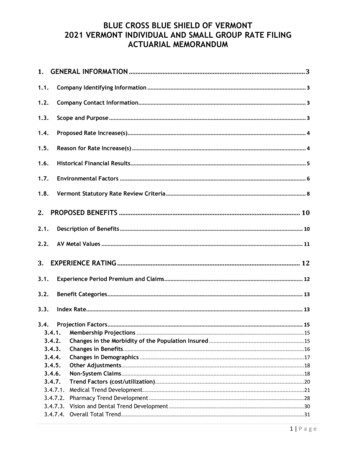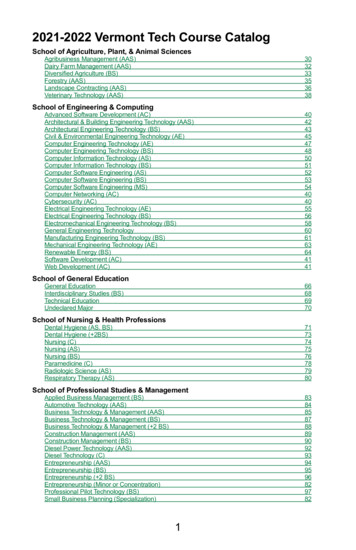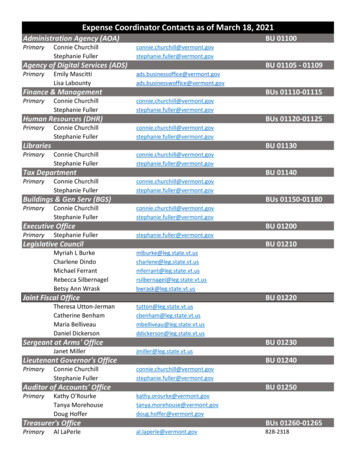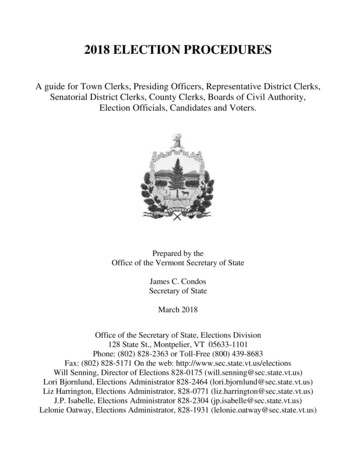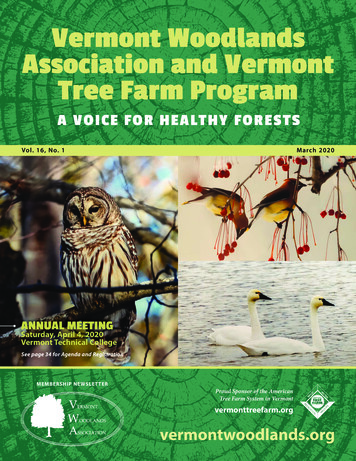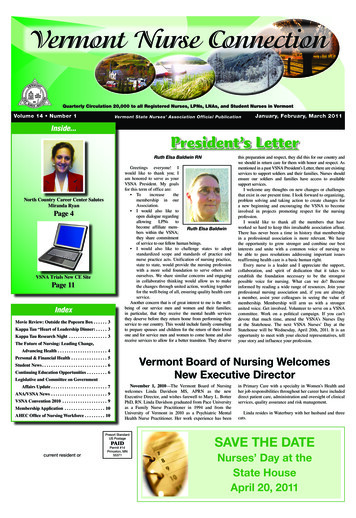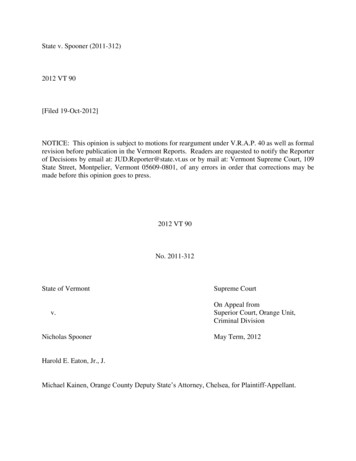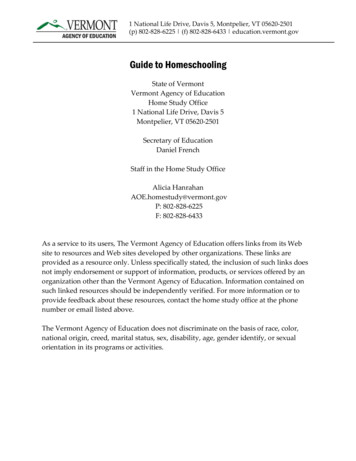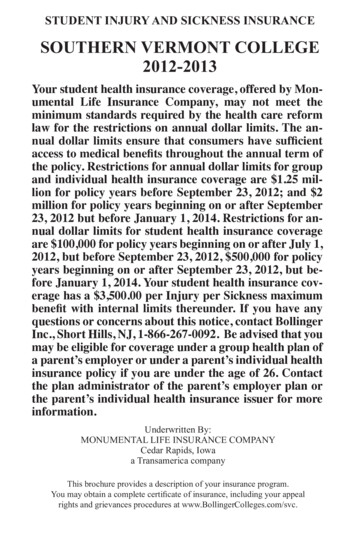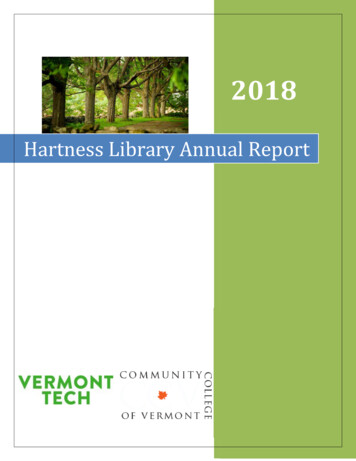
Transcription
2018Hartness Library Annual Report
Hartness Highlights 2018Hartness Software MigrationsIt's been a year of software migrations for Hartness Library. Except for the website, which isstill hosted on servers at OCIT, these migrations move the VSCS libraries from OCIT hosting andmaintenance to third-party software as a service (SaaS). This was seen by both the VSCSlibraries and OCIT as the most efficient way to ensure reliable access and service and theimproved service to our students is noticeable. The Hartness Library unified website launched officially in January 2018. The newwebsite is on the WordPress platform which OCIT is better able to secure and host.Longer term plans are to migrate the website hosting to a third-party. In a joint project with the other VSCS Libraries, Hartness migrated to a new bookcatalog in May 2018. Koha is a cloud-based catalog with software as a service fromBywater Systems. Hartness hosted and organized VSCS libraries training on Koha, with a3-day training at Vermont Tech in May 2018. The cooperation between staff at thelibraries enabled a smooth transition and strengthening of service. Requesting a book using the Search Hartness discovery system is easier. Users can nowtrack book and article requests from their own library account. This new third-partysystem from OCLC called Tipasa was implemented in July 2018 and allows users toeasily request books within the VSCS libraries and through inter-library loan. Finally, the authentication system which verifies user entitlements for access to Librarysubscription resources was shifted from a server at OCIT to OCLC for third-party hostingand maintenance in October 2018. This has freed up OCIT resources and means remoteissues are addressed proactively before issues arise – an improvement which isessential in our continuing to provide reliable remote access to our resources.2
Strategic PlanningHartness Library has been working on developing a strategic plan for 2018-2023 to guide thedevelopment of resources and services for the coming 5 years. The draft priorities weredeveloped with attention to also meeting the goals of the recently released CCV and VTCstrategic plans. Hartness Library Strategic priorities 2018-2023 (Nov 2018 draft) is theculmination of Phase 1 in the process. The 5 key priorities and associated strategies outlined inthe draft were developed with staff over the fall semester and were based on the SOAR analysisconducted with staff in summer 2018.3
This spring we are concluding Phase 2, stakeholder input, evaluating and interpreting the datafrom over 400 survey responses to questions about Library resources and services from CCVand VTC faculty, students and staff. At the May all Hartness staff meeting we will review theseresults together, finalize the strategic priorities with stakeholder and staff input and, developan implementation and assessment plan. Our current strategic priorities and our progress areavailable under Mission & Policies on the Hartness homepage.VSCS LibrariesIn addition to our collaborative work on the catalog, proxy and interlibrary loan systemmigrations in 2018, VSCS Library Council moved to create an OER Task Force consisting oflibrarians, faculty, and administrators from throughout the VSCS. The group convened in the fallof 2018 and discussed the benefits of OER for students and faculty, the alignment of OER withthe strategic goals of the VSCS colleges and universities, and potential steps toward having asystem wide definition of no-cost and low-cost OER course designations.The VSCS libraries participated in the Vermont Humanities Council 2017 and 2018 VermontReads Statewide Community Reading Programs. In February 2018, students, faculty and staffjoined together to read Jacqueline Woodson’s Brown Girl Dreaming in honor of Black HistoryMonth. The 2018 selection was Bread and Roses, Too, by Katherine Paterson, a novel ofhistorical fiction that tells the story of the 1912 “Bread and Roses” strike in the Lawrence,Massachusetts textile mills. Events were held at Hartness in Randolph and Williston and anonline guide was created to celebrate the eads4
Hartness Activities around the RegionHartness Librarians at CCV and VTC are active within both Colleges, conducting workshops andcontributing to College-wide committees. We also reach out to contribute to our professionand community at the Vermont State Colleges and State level.2018 Leadership and PresentationsHartness Library Director Jane Kearns was elected for a second term as Vermont Consortium ofAcademic Libraries (VCAL) President for 2018-2019.April 2018, Jane represented VSCS libraries and VCAL at the Vermont Library Summit, astrategic planning session with VLA leadership, Vermont School Library Association, GreenMountain Library Consortium, Vermont Department of Libraries, and Board of Libraries.May 23rd, 2018 Vermont/New Hampshire Annual Inter-Library Loan meeting was hosted atHartness Library. The theme of the meeting, which was organized by Hartness remote servicescoordinator Kim Hannon-Brobst, was using open access in inter-library loan.In October, Hartness hosted the VSCS Reference Librarians’ Retreat at CCV Montpelier. Thisyear’s theme was best practices in distance reference services, including embeddedlibrarianship, chat reference, and LMS integration.PresentationsGatti, E., Boss, S., Keogh, M., & Yazdani, J. (2018, May 23). Low and no cost textbook solutions:Developing a system-wide OER infrastructure. Panel discussion presented at Vermont StateColleges Academic Retreat, Castleton, VT.Hartness Library Usage 2018 OverviewEach year we look at all the usage statistics for our electronic and print collections to evaluatewhat is being used and in what format, to inform our collection development practices. Wework closely with faculty to ensure our print and electronic collection is accessible, current andsupports the curriculum at both colleges. The following provides a snapshot of the activities ofHartness Library online and in our physical spaces for 2018 all semesters. Combined CCV/VTCFTE decreased from fall 2017 to fall 2108 by 8 FTE.5
Electronic Resource UsageThere was a 17% increase in full-text access of eBook chapters in 2018, continuing themigration of users from print to eBook. We added a major computer science, business, scienceand technology eBook collection from O’Reilly Safari which is growing in popularity to use asclass texts. Usage of the APA DSM-5 doubled and there was a slight increase in usage of twomajor reference collections: Credo and GVRL.Electronic resource usage overall decreased in 2018. Usage is about level with 2016 after anunexplained jump in Films on Demand usage in 2017. Other than the Films on Demand drop,the decrease in usage was spread across the resources evenly.Also new in 2018, Anatomy TV A&Pand dental modules database. TheA&P portion was funded by a CCVPerkins grant for this year. The forfaculty area provides supplementalmaterials and handouts to supportthe curriculum.6
7
Print CirculationPrint circulation dropped 16% in 2018 and trends with increased eBook usage (17% increase).Loans directly to CCV faculty/staff and students accounted for 20% of loans; 27% were loans toVTC faculty, staff and students. The budget line for books reflects this trend: In FY19 27% ofthat line was spent on subscription package eBooks (in FY18 44% of the books line was spent onindividual purchase and subscription eBooks and that will likely increase in FY19). Interestingly,print books borrowed from other VSCS Libraries more than doubled in 2018 as reflected in theinter-library loan statistics. This is probably due to the ease of placing requests using the newTipasa software. For CCV students and remote VTC users, the request experience is the exactsame whether the book is coming from Hartness or another VSCS Library.Physical Books/Media Circulated & ILL Books 510108400079607560634720000201420152016Physical Books/Media Circulated82017ILL Books Borrowed2018
Interlibrary and Intra-library LoanCCV and VTC Students borrowed heavily from other VSCS libraries in 2018 while circulation ofitems from Hartness dropped. Of the 771 books borrowed by Hartness users from otherlibraries in 2018, 556 were from other VSCS libraries (in 2017, 253 books were borrowed fromother VSCS schools). The launch of Tipasa, the new inter-library loan system, has made it easierfor users to request from the other VSCS schools. It is also now easier for VSCS library staff toplace and fulfill these requests, fully taking advantage of the shared library collections.In 2018, librarians started proactively reviewing article and book requests to locate openaccess, items owned (document delivery) and for reference intervention when appropriate. Ifappropriate for collection, we sometimes purchase eBook versions instead of making aninterlibrary loan request. Purchased eBooks can be available for the user within a couple ofhours.Document delivery is a request for an article or book in our collection, which the user couldhave located and accessed on their own, but instead requested through inter-library loan. Thisis also the first year we have shown the Open Access books and articles we have located andsent to users in the interlibrary loan statistics.9
Hartness Subject Guides, Tutorials and VideosThe librarian-created subject guides are very useful for getting students started on research.With the rollout of the new website, subject guides have become the entry point to subjectspecific databases. The reduction in views of basic subject guides, reflects the increased usageof Search Hartness Discovery Service to search across all databases and the addition ofresearch instructional guidance in other pages of the website. Fake News, OER, Nursing andAllied Health guides continue to be the most heavily used guides.As we prepare to migrate to Canvas, we are evaluating how we use these guides. We haveexpanded our software license with Springshare, the platform these are based on, and this willbe the basis of Hartness presence in Canvas courses in fall 2019. The new Springshare platformalso includes a tutorial wizard and survey component and allows us to track usage of thetutorials as we do now for subject guides.Our Hartness Library YouTube channel, with 376 subscribers, houses our brief conceptual videotutorials covering all aspects of the research process that our users need. These are alsoincorporated into the instructional pages on the Hartness Library website, and the self-pacedtutorials, like the Library Orientation. With Moodle and the new Canvas LMS, embeddingHartness YouTube videos in a course page is easy and automatic.10
Hartness Subject Guides 0020142015201620172018WebsiteThis was the first year with a single Hartness website. The website committee has continued tomeet periodically to evaluate user input and discuss areas where changes are needed.Generally, changes are implemented in the summer, when there may be less disruption for theuser. Users can access Search Hartness from Moodle or a shared link directly, bypassing thewebsite, which accounts for part of the decline in sessions. Search Hartness sessions increased6% in 2018 (109033 in 2017 to 115409 in 2018).Access using a mobile device increased by 16% in 2018 as access from a desktop or tabletdecreased. As we focus on improving online access to our resources, ensuring our site workswell with mobile devices will be important. In 2018, 67% of users accessed from a Windowsdevice, 16% Mac, 7% iOS, 5% Chrome and 3% Android. For browsers, about 55% accessed usingChrome, 14% Safari, 12% Edge and 9% Firefox.11
Marketing & Social MediaThe marketing committee reconvened in summer 2018 to look at initiatives at both thecolleges. Social media was expanded to add a Library Instagram account in the summer. Thereare predictions that Instagram will continue to grow but Facebook may continue to lose users12
due to public mistrust of the platform after criticism of Facebook privacy issues and datamining. The Instagram account is growing and attracting users. Library staff added widgets intheir email signatures to link to the library Instagram and Facebook pages. The fall social mediacontest was a Hartness “Study Buddy” photo contest.2018 First Place #HartnessStudyBuddy photoThe Library as PlaceThe gate count increased by 34% in Williston and decreased by 4.5% in Randolph. The AllCollege book club is very active and now meets monthly. All Hartness users are welcome to join13
in person in Williston or Randolph or, by Zoom. Knitting circles have also become popular onboth the campuses.The therapy dogs and snacks during exam weeks are still a popular draw for students. StudentActivities in Randolph has been hosting regular events in the Library including a Nomad CoffeeBar, Build-a-Bear Workshop and commuter coffees, which students seem to love. The Galleryhas seen a variety of shows over the year with artists cycling through the 2 galleries and displaycases by semester.Vermont artist, Jan Fowler, is a landscape painter and her work reflects her feelings of solace and reverence for theland.14
Helping Students & Faculty Find the AnswerReference & Chat ServicesOverall, reference and directional interactions are up. CCV and VTC questions handled atHartness Randolph are also up. CCV Reference questions handled by CCV Librarians were upfrom 2017, both directional and research questions.15
16
Since the launch of the new beta website in fall 2017 at VTC and with the full launch in 2018,proactive chat popup appears a few minutes into a user’s session. The impact on usage of chatservices has been significant, with an increase of 71% in sessions for CCV users and 112% forVTC users. We believe reference and directional questions are also up as a result. The windowpops up in the lower corner of the screen and we have not had any negative feedback aboutthe popup.17
Reference Services AssessmentIn an effort to assess the impact of our resource usage, reference and instruction efforts, westarted collecting feedback in a Librarian Experience survey in 2018. The data collected over thethree 2018 semesters shows a positive impact on users self-reported satisfaction with the helpreceived finding information, confidence in doing research, research skills and finally 83% saidthey would visit Hartness again for help. In 2018, we streamlined the reference and assessmentdata metrics we are collecting at our various VTC and CCV service points.18
Library Instruction and Embedded LibrariansOver the three 2018 semesters, librarians posted regular instructional posts as embeddedlibrarians in Moodle classes. Similar to content on the website which students may not find ontheir own, these posts provide instruction about things such as searching the library, findingpeer-reviewed articles, the basic research steps, citing sources, etc.VTC’s librarians visited 46 classes for face-to-face library instruction, reflecting an effort to visitevery basic English class once a semester and higher-level classes with a research component.Embedded classes increased again in 2018 from 95 sections to 98, due to the growth of onlineprograms. We were also embedded in more English classes this year which positioned us tosupport information literacy instruction in the Moodle class.Embedded Program AssessmentCCV faculty are increasingly seeing the value of requiring library consultations when using anEmbedded Librarian. Over 56% of faculty on average planned to have a required consultationeach semester in 2018, as reported on their Embedded Librarian request form. This is up from48% in 2017. When surveying the faculty on their satisfaction with the service, this option torequire an interaction with the librarian is seen as adding value.In their open-ended survey responses, several faculty members said they will consider adding arequired consultation with the librarian. For example: “This was my first time using theembedded program and I found the resources incredibly valuable, as did some of my students.One thing I would change would be to require students to use the service rather than to19
strongly suggest, as there were students who did not take advantage of the support and theirgrades suffered as a result with the assignment.” Other comments showed perceivedimprovements from having adjusted their assignments to maximize use of the librarian: “[MyClass Librarian] gave me suggestions on how to better include the services into my course. Ifound the assignment adjustment I made to the research processes to be successful.” Forfaculty who did require a librarian consultation, their assessment of students’ use of the serviceand the quality of sources went up.In the VTC Fall 2018 Embedded Librarian Survey, the majority of students (24 out of 30 polled)indicated that the resources in the Hartness Library box in Moodle was useful. 70% of studentsstrongly agreed with 5 key statement about the program. Of the 5 faculty members thatcompleted the survey, 60% replied with some level of agreement to the 5 key statements, butthe remaining 40% where neutral in their responses indicating some follow-up is needed toensure the program is meeting their needs.20
Supporting FacultyUsing OER and Other Text AlternativesLibrarians have continued supporting faculty in seeking low-cost alternatives to expensivetextbooks. We added a page to our website in the faculty section called Textbook Alternatives.In addition to our OER Guide, this set of tips and guidelines for faculty is helpful as instructorsconsider ways to use both freely available resources and library subscription database contentand eBooks. Faculty are becoming more aware of the wide availability of “Unlimited User”eBooks as well as streaming videos, and reference eBook sources as potential teachingmaterials.Initiatives in 2018 included an OER pilot program at Vermont Tech. Librarians helped 2 facultyfind OER and Library resources to use instead of standard textbook. Faculty and students weresurveyed after the class and feedback was supportive of continuing the effort. This was a smallpilot so we will continue outreach about the program and assessing impact. The studentresponse on impact to their learning indicated that 100% reported financial savings and 72%responded that they felt increased engagement in their class because of OER.21
Faculty OutreachThere was a gradual increase in course consultations and research questions coming from CCVfaculty and staff, frequently concerning research assignment ideas, OER resource suggestions,and incorporation of LIM tools. CCV User Satisfaction Survey also elicits professionaldevelopment suggestions from faculty who use the Embedded Librarian.22
In the distributed system of CCV, teaching faculty, Academic Coordinators, and Learning CenterAcademic Mentors are critical connections between students and librarians. CCV seeks tocontribute to faculty professional development wherever appropriate. In 2018, CCV Librariansled or co-led several presentations and workshops, both in person and online, covering topicssuch as integrating library resources, scaffolding information literacy skills in courseassignments, and replacing traditional textbooks with OER and library materials. These havelargely been in concert with other groups around the college, like Curricular Committees andthe Learning and Career Center, leading to improved collaboration between librarians andcrucial stakeholders within the college.23
Priorities & Plans for FY20 Finalize and plan implementation and assessment of 2018-2023 Hartness LibraryStrategic Plan. Improve User experience online and in-person with particular attention to nontraditional and students with disabilities. Promote OER at our Colleges and in the VSCS. Continue to work with faculty to supportthem in reducing textbook costs by using library and open access resources in theirclasses. Develop collection with a goal of balancing curriculum support and helping studentsreduce textbook costs. Continue to critically assess and evaluate our reference services and information literacyinstruction at both Colleges to ensure that our efforts are effective and sustainable. Expand awareness of resources and services.Prepared By: Jane Kearns/ Eileen Gatti 04/16/201924
contributing to College-wide committees. We also reach out to contribute to our profession and community at the Vermont State Colleges and State level. 2018 Leadership and Presentations Hartness Library Director Jane Kearns was elected for a second term as Vermont Consortium of Academic Libraries (VCAL) President for 2018-2019.
